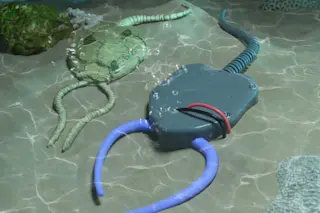A new soft robot grows like a creeping vine to weave its way around obstacles and nose into tiny spaces. From researchers at Stanford University, the robot consists mostly of an inflatable tube that's been folded in on itself and coiled up. To move, a pneumatic pump fills the tube with air, pushing it forward by drawing material from the inside. In initial tests, the robot stretched as far as 72 meters from an initial length of 28 centimeters and reached speeds of over 20 mph.
The researchers put their expanding tube-bot through a series of tests, scrunching it through tiny cracks, spiraling it into the air to serve as an antenna, moving it through a bed of nails, using it to lift a heavy box and maneuvering it through a tight space to douse a fire with water held inside. They've figured out how to control its movements by ...














